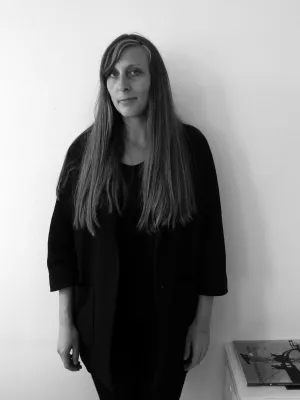
Maj Hasager
Rektor

Three Structures Touching
Författare
Summary, in English
Solo exhibition at Propellor Gallery, Santa Monica, US
When Copenhagen-based Hasager first visited Santa Monica for a six-month residency in 2018, she was drawn to 18th Street’s Culture Mapping 90404 project, a resident-led oral history archive and mapping platform for the 90404 zip code, as it complemented her artistic process of plumbing the depths of personal memories, oral histories, and hyperlocal cultural identities to reveal deeper sociopolitical complexities and imbalances of power. In her 2019 presentation titled Iterations, Hasager delved into the history of contested places in Santa Monica (such as the construction of the 10 Freeway, which displaced thousands of families in the largely Black and brown working class Pico Neighborhood; and Nikkei Hall, a former Japanese community center slated for demolition and then preserved through a landmark designation process), Hasager became deeply interested in the myriad formal and informal ways we remember and honor places of cultural significance in our communities.
During this initial residency, Hasager also formed a close relationship and collaborative partnership with Carolyne and Bill Edwards of the Quinn Research Center, an archive of the small but influential Black community in the Santa Monica Bay area from the early 20th century forwards. The photographs, magazines, advertisements, letters, and ephemera the Edwardses have painstakingly preserved over decades catalogue the stories of a resilient community, and undergird Hasager’s artistic production. The title of the exhibition, Three Structures Touching, refer to the restrictive and somewhat archaic requirements necessary for historic district designation in the US (that multiple structures must be of “architectural significance” and “touching” in order to be considered), and reference the Edwardses long-standing goal to have the important sites of the Santa Monica Black experience officially recognized as places of cultural significance by the City. One such site is the Philomathean Building, the home of a charity society founded by a group of Black women in the early 20th century and purchased in 1921 (a feat in and of itself, when restrictive racially-based covenants made property acquisition incredibly difficult). The society still operates today, giving scholarships to young people and hosting Black-owned small businesses in its building’s several storefronts. In trying to realize these goals of preservation and recognition, the collaborators have been confronted with an inherently inequitable system of landmark preservation in this country (only 3% of landmark sites in the City of LA are linked to Black history). They have had to be resilient and imaginative, just as the Philomathean founders were 100 years ago. To dig into these issues around landmarks and how we remember our places of cultural significance, Hasager and Quinn Research Center will participate in a virtual roundtable discussion with writer and researcher Maria Rosario Jackson and landmarks expert Ruthann Lehrer of the Santa Monica Conservancy on August 14, 2021 at 11am. Register and learn more here.
When Copenhagen-based Hasager first visited Santa Monica for a six-month residency in 2018, she was drawn to 18th Street’s Culture Mapping 90404 project, a resident-led oral history archive and mapping platform for the 90404 zip code, as it complemented her artistic process of plumbing the depths of personal memories, oral histories, and hyperlocal cultural identities to reveal deeper sociopolitical complexities and imbalances of power. In her 2019 presentation titled Iterations, Hasager delved into the history of contested places in Santa Monica (such as the construction of the 10 Freeway, which displaced thousands of families in the largely Black and brown working class Pico Neighborhood; and Nikkei Hall, a former Japanese community center slated for demolition and then preserved through a landmark designation process), Hasager became deeply interested in the myriad formal and informal ways we remember and honor places of cultural significance in our communities.
During this initial residency, Hasager also formed a close relationship and collaborative partnership with Carolyne and Bill Edwards of the Quinn Research Center, an archive of the small but influential Black community in the Santa Monica Bay area from the early 20th century forwards. The photographs, magazines, advertisements, letters, and ephemera the Edwardses have painstakingly preserved over decades catalogue the stories of a resilient community, and undergird Hasager’s artistic production. The title of the exhibition, Three Structures Touching, refer to the restrictive and somewhat archaic requirements necessary for historic district designation in the US (that multiple structures must be of “architectural significance” and “touching” in order to be considered), and reference the Edwardses long-standing goal to have the important sites of the Santa Monica Black experience officially recognized as places of cultural significance by the City. One such site is the Philomathean Building, the home of a charity society founded by a group of Black women in the early 20th century and purchased in 1921 (a feat in and of itself, when restrictive racially-based covenants made property acquisition incredibly difficult). The society still operates today, giving scholarships to young people and hosting Black-owned small businesses in its building’s several storefronts. In trying to realize these goals of preservation and recognition, the collaborators have been confronted with an inherently inequitable system of landmark preservation in this country (only 3% of landmark sites in the City of LA are linked to Black history). They have had to be resilient and imaginative, just as the Philomathean founders were 100 years ago. To dig into these issues around landmarks and how we remember our places of cultural significance, Hasager and Quinn Research Center will participate in a virtual roundtable discussion with writer and researcher Maria Rosario Jackson and landmarks expert Ruthann Lehrer of the Santa Monica Conservancy on August 14, 2021 at 11am. Register and learn more here.
Avdelning/ar
- Konsthögskolan i Malmö
Publiceringsår
2021-07
Språk
Engelska
Dokumenttyp
Konstnärligt arbete
Förlag
18th Street Arts Center & Santa Monica Youth Orchestra (SMYO)
Ämne
- Visual Arts
Status
Published